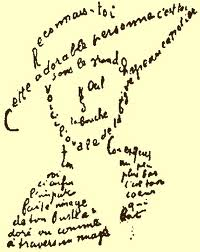The war in 1914 was a tragically influential time for writers. From it, a modernist era was created. this contained works from artists that added a historical base while experimenting with the human and personal qualities within them. People began taking risks because the war among them brought out different ideas, passions and personalities that sometimes strengthened or lessened the excellence. One of the greatest experiments was with format and the representation of images using text. Guillaume Apollinaire was infamous for that sort of work. He had introduced something completely new and raw, purposefully allowing others to visualize his emotions. In his collection of poems known as Calligrammes, subtitled Poems of war and peace. (1918) he was able to construct his time in the war for his audience and demonstrate the ways in which his life was affected.
The Oxford Dictionary describes a calligramme as,
“A word or piece of text in which the design and layout of the letters creates a visual image related to the meaning of the words themselves.”
However, Apollinaire describes his calligrammes as,
“The Calligrammes are an idealization of free verse poetry and typographical precision in an era when typography is reaching a brilliant end to its career, at the dawn of the new means of reproduction that are the cinema and the phonograph.”
— Guillaume Apollinaire, in a letter to André Billy (see wikipedia
)
These are a few of his most famous Calligrammes:
 (see wikipedia)
(see wikipedia)
 (see Wikipedia)
(see Wikipedia)
 (see Artthrob)
(see Artthrob)
 (see JacquesMottier)
(see JacquesMottier)
